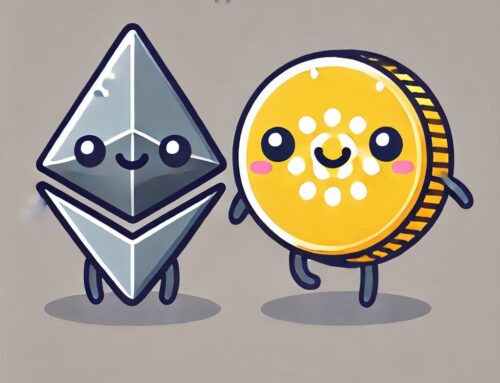Taming the Transaction Fee Beast: Your Humorous Guide to Understanding and Optimizing Cardano Fees (Because Every ADA Counts!)
Let’s have a frank and funny chat about something that can make even the most seasoned crypto enthusiast scratch their head in confusion: transaction fees! No, we’re not talking about those sneaky hidden charges your bank loves to spring on you (though, let’s be honest, sometimes blockchain transaction fees can feel a bit mysterious). We’re diving deep into the world of Cardano transaction fees, demystifying how they work, why they exist, and, most importantly, how you can outsmart the system and maybe, just maybe, save a few precious ADAs along the way!
Think of transaction fees like the toll you pay to use the digital highway of the Cardano network – you gotta pay to play, but you also want to make sure you’re not getting ripped off at the toll booth. So, buckle up, bargain hunters, and let’s embark on a humorous yet highly practical journey to understand, optimize, and maybe even laugh in the face of Cardano transaction fees!
Why Do We Even Need Transaction Fees? (Is Nothing in Life Truly Free?)
Before we get lost in the weeds of Cardano fees and complicated calculations, let’s take a step back and understand why blockchain transaction fees exist in the first place. Why can’t everything just be free, like samples at Costco? In a decentralized network like Cardano, transaction fees serve several crucial purposes, acting as the unsung heroes that keep the whole system running smoothly (and securely!):
Network Security (Paying the Digital Bouncers!): Transaction fees incentivize the network’s validators (stake pool operators) to diligently process transactions and maintain the integrity of the blockchain, which is essential for the long-term health of the network. It’s like paying the digital bouncers at a super-exclusive blockchain club, ensuring that only legitimate transactions get through the velvet rope, and the club remains secure and orderly. These transaction fees are essential for incentivizing good behavior on the network.
Preventing Spam (Say No to Digital Junk Mail!): Transaction fees help prevent spam and malicious activity on the network by making it costly to flood the system with useless or harmful transactions. It’s like putting a price on posting unwanted advertisements, making it prohibitively expensive for spammers to clog up the network with digital junk mail and useless data. These fees help keep the blockchain clean and efficient.
Network Maintenance (Keeping the Lights On and the Roads Paved!): Transaction fees contribute to the long-term sustainability of the network, ensuring that it can continue to operate and evolve. A portion of the fees are funneled to the treasury funds, which can then be used to further develop the Cardano network, fund new projects, and implement improvements to the core protocol. It’s like contributing to a general fund for building new roads and bridges for the Cardano community, ensuring that the digital infrastructure remains robust and well-maintained. These fees are therefore an investment in the future of the blockchain.
Cracking the Code: How Are Cardano Transaction Fees Calculated? (It’s Not Rocket Science, But It’s Close!)
Now, let’s get to the burning question on everyone’s mind: how are transaction fees on Cardano actually calculated? Are they pulled out of thin air? Are they determined by a magic eight ball? Thankfully, no. Cardano transaction fees are not fixed; they are calculated dynamically, based on several factors, to ensure that the network operates efficiently, and that fees remain reasonable, even during times of high congestion. Here’s a breakdown of the key components that go into the Cardano fee calculation:
Transaction Size (Size Matters in the Crypto World!): Cardano transaction fees are primarily based on the size of the transaction, measured in bytes. Larger transactions, which typically involve more inputs and outputs, require more processing power and network resources, and therefore cost more to process. It’s like paying more for a larger package to be shipped – the bigger and heavier it is, the more it costs to transport.
Minimum Fee (The Price of Admission!): There’s a minimum fee, or constant, that every Cardano transaction must pay, regardless of its size or complexity. This minimum fee provides a baseline for paying for the transaction processing, and ensures that even the smallest transactions contribute to the network’s sustainability. It’s like having a minimum processing charge, just to use the network at all.
Dynamic Calculation (Adapting to the Flow!): Cardano uses a dynamic fee calculation formula, which adjusts based on network congestion. When the network is busy, and there are a lot of transactions waiting to be processed, fees may increase slightly to reflect the higher demand for network resources. It’s like surge pricing for digital transactions, where prices can increase during periods of high demand, and decrease when the network is less busy.
Fee Parameters (Adjustable Dials Behind the Scenes!): The Cardano protocol includes adjustable parameters that can influence the fee calculation, including the variable “a” and the constant “b” in the formula. These parameters can be adjusted through governance proposals to fine-tune the fee calculation mechanism and respond to changing network conditions, ensuring that fees remain fair and reasonable.
The Fee Formula: It’s Math Time! (But We’ll Keep It Simple, We Promise!)
While the exact fee calculation formula can look a bit intimidating at first glance (especially if you’re allergic to math), it’s actually quite straightforward in principle. Here’s a simplified version of the Cardano transaction fee formula:
Transaction Fee = (a * Transaction Size) + b
Where:
a is a variable that can change depending on network conditions, and reflects the current demand for network resources.
Transaction Size is the size of the transaction in bytes, which is determined by the amount of data included in the transaction, including inputs, outputs, and metadata.
b is the minimum fee, which is a constant value that ensures a base level cost for every transaction.
Understanding Transaction Components: What Makes a Transaction “Big” or “Small”? (It’s All About the Digital Footprint!)
To truly understand how transaction fees are calculated, it’s helpful to look at the key components of a Cardano transaction that affect its size, and therefore its cost. The larger the transaction, the more data it contains, and the more it will cost to process.
Inputs (Where the Funds Come From): Inputs are references to the unspent transaction outputs (UTXOs) that you are using to fund the transaction. More inputs mean a larger transaction size and a higher fee, as each input adds data to the overall transaction size. It’s like using several gift cards to pay for something – the more cards you use, the more data needs to be included in the transaction.
Outputs (Where the Funds Are Going): Outputs specify where you are sending the funds, including the recipient address and the amount. The more outputs you have (e.g., sending funds to multiple recipients in a single transaction), the larger the transaction size, and the higher the fee, as each output adds data to the transaction size. It’s like having to pay for shipping to multiple addresses you’re sending to, as opposed to a single address.
Metadata (Extra Information, Extra Bytes): If you include metadata in your Cardano transaction, this will also increase the size of the transaction, and therefore the fee. Metadata, while useful, adds extra data to the transaction, and increases its overall size. It’s like adding extra documents to a package, which increases its weight and shipping cost.
Complex Scripts (Smart Contracts and Fancy Footwork): If you are interacting with smart contracts, or using complex transaction scripts, this will also increase the transaction size and the fees, as smart contracts often involve more complex logic and data, which needs to be included in the transaction.
How to Optimize Transaction Fees: Become a Crypto Frugal Master!
While you can’t completely eliminate transaction fees (unless you somehow convince the blockchain fairies to work for free), there are several smart strategies that you can use to optimize them, minimize costs, and save a bit of ADA for more important things (like buying more crypto, obviously!). Here are a few tips and tricks to become a Cardano transaction fee optimization master:
Consolidate UTXOs (Tidy Up Your Digital Receipts!): If you have a large number of small UTXOs scattered across your wallet, consider consolidating them into fewer, larger UTXOs before making a transaction. This can reduce the number of inputs required for your transactions, and therefore reduce the overall transaction fee. You can do this by sending all your funds to a single address that you control.
Avoid Unnecessary Metadata (Keep it Lean and Mean!): Only include metadata in Cardano transactions when it’s truly necessary, as including extra information will increase the transaction size and therefore the fees. Metadata is a powerful feature, but it should be used judiciously, to avoid unnecessary costs.
Use Simpler Transactions (Keep it Simple, Stupid!): Whenever possible, use simple transactions with fewer inputs and outputs, as larger and more complex transactions will naturally have higher fees. If you’re just sending ADA to a single address, keep it simple to minimize costs.
Monitor Network Congestion (Timing is Everything!): Be aware of network congestion, and avoid making transactions during peak hours, when transaction fees are likely to be higher due to increased demand for network resources. Check network conditions before sending transactions, and try to send them during off-peak hours, if possible.
Use Fee Estimation Tools (Know Before You Go!): Many Cardano wallets and blockchain explorers provide fee estimation tools, which can help you determine the optimal fee for your transaction, based on current network conditions. These tools can help you avoid overpaying for fees, and ensure that your transactions are processed efficiently.
The Takeaway: Transaction Fees – A Necessary Part of the Cardano Ecosystem, But Not a Reason to Panic!
Transaction fees are a necessary and integral part of the Cardano network, providing essential incentives for validators, preventing spam, and ensuring the long-term sustainability of the blockchain. By understanding how Cardano transaction fees are calculated, and by using some of these practical optimization strategies, you can make informed decisions about your transactions, minimize costs, and navigate the Cardano ecosystem like a pro. It’s not just about sending ADA; it’s about doing it efficiently, responsibly, and maybe even with a little extra ADA left in your wallet for a rainy day!





